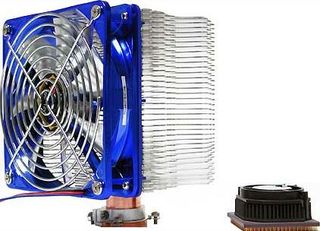10 Mammoth CPU Coolers: Size Does Matter
XXL Coolers Are Becoming A Must-have

CPU coolers are a necessary evil these days and we look at some of the bigger models on the market. The one illustrated above is nearly two pounds, dwarfing ten-year old coolers that weighed a few ounces. We took a look at ten different super-sized coolers and try them out on a variety of motherboards and socket combinations.
Are these the first signs of the madness towards which the industry is heading? It may not be madness at all. The reason why coolers keep getting bigger is that the processor manufacturers have lofty ambitions. High clock speeds and dual-core processors lead directly to hotter CPUs. In the meantime, Intel's Pentium 4 580 produces up to 130 watts of heat that has to be dissipated. At 3.8 GHz, even the boxed cooler from Intel starts to reach its limits. In addition, at such high temperatures, the cooler has to spin at such a high speed that it makes a racket, which can be a serious distraction to getting work done.
The LGA775 socket has been on the market for some time now - enough time for the manufacturers to develop efficient and quiet coolers for this socket. We decided it was time for us to take inventory and determine which coolers for the platform are good. Nearly all manufacturers produce coolers for more than one socket by now, which means that these coolers work for Athlon 64 Sockets 939 and 754, and in some cases can still be used for Socket A and Socket 478 as well.
When we started looking, one thing became obvious right away: almost all manufacturers have bid farewell to the Intel reference design. When we conducted our last cooler test 5 Cool P4 Coolers Protect Your P4 From Heatstroke , each cooler looked like the next. This time, the coolers exhibited substantial diversity, which frankly, is a sight for sore eyes.
As mentioned earlier, the other major trend is towards larger and larger coolers. Often enough, when it comes to coolers, size seems to trump all sense of reason. Some coolers are so large that they beg the question of whether the case will fit after they are installed. Along with compatibility lists for motherboards, similar lists for cases might soon become necessary!
Stay on the Cutting Edge
Join the experts who read Tom's Hardware for the inside track on enthusiast PC tech news — and have for over 25 years. We'll send breaking news and in-depth reviews of CPUs, GPUs, AI, maker hardware and more straight to your inbox.
Current page: XXL Coolers Are Becoming A Must-have
Next Page The Test Subjects In DetailMost Popular


